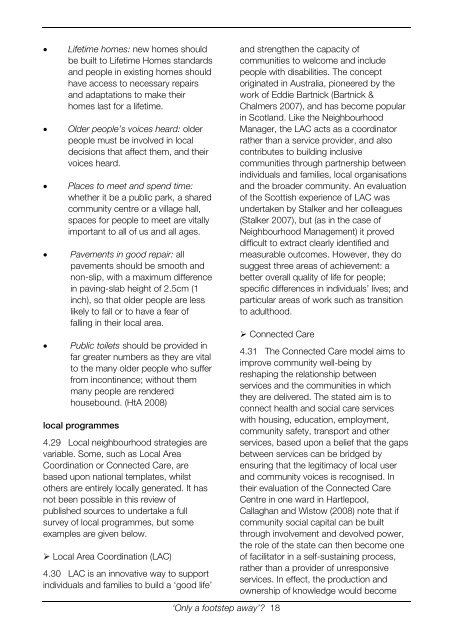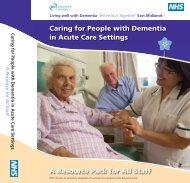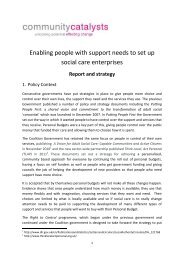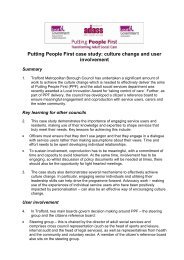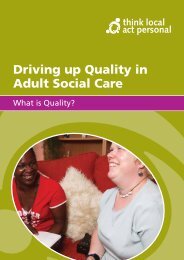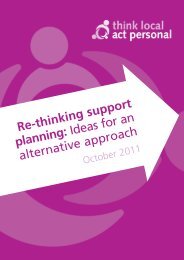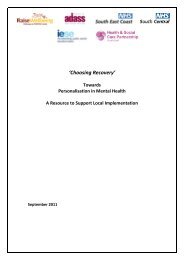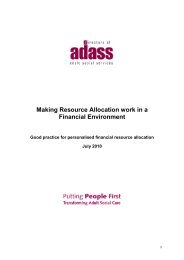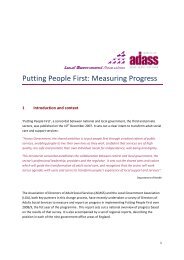'Only a footstep away' - Skills for Care - Think Local Act Personal
'Only a footstep away' - Skills for Care - Think Local Act Personal
'Only a footstep away' - Skills for Care - Think Local Act Personal
- No tags were found...
You also want an ePaper? Increase the reach of your titles
YUMPU automatically turns print PDFs into web optimized ePapers that Google loves.
• Lifetime homes: new homes shouldbe built to Lifetime Homes standardsand people in existing homes shouldhave access to necessary repairsand adaptations to make theirhomes last <strong>for</strong> a lifetime.• Older people’s voices heard: olderpeople must be involved in localdecisions that affect them, and theirvoices heard.• Places to meet and spend time:whether it be a public park, a sharedcommunity centre or a village hall,spaces <strong>for</strong> people to meet are vitallyimportant to all of us and all ages.• Pavements in good repair: allpavements should be smooth andnon-slip, with a maximum differencein paving-slab height of 2.5cm (1inch), so that older people are lesslikely to fall or to have a fear offalling in their local area.• Public toilets should be provided infar greater numbers as they are vitalto the many older people who sufferfrom incontinence; without themmany people are renderedhousebound. (HtA 2008)local programmes4.29 <strong>Local</strong> neighbourhood strategies arevariable. Some, such as <strong>Local</strong> AreaCoordination or Connected <strong>Care</strong>, arebased upon national templates, whilstothers are entirely locally generated. It hasnot been possible in this review ofpublished sources to undertake a fullsurvey of local programmes, but someexamples are given below.‣ <strong>Local</strong> Area Coordination (LAC)4.30 LAC is an innovative way to supportindividuals and families to build a ‘good life’and strengthen the capacity ofcommunities to welcome and includepeople with disabilities. The conceptoriginated in Australia, pioneered by thework of Eddie Bartnick (Bartnick &Chalmers 2007), and has become popularin Scotland. Like the NeighbourhoodManager, the LAC acts as a coordinatorrather than a service provider, and alsocontributes to building inclusivecommunities through partnership betweenindividuals and families, local organisationsand the broader community. An evaluationof the Scottish experience of LAC wasundertaken by Stalker and her colleagues(Stalker 2007), but (as in the case ofNeighbourhood Management) it proveddifficult to extract clearly identified andmeasurable outcomes. However, they dosuggest three areas of achievement: abetter overall quality of life <strong>for</strong> people;specific differences in individuals’ lives; andparticular areas of work such as transitionto adulthood.‣ Connected <strong>Care</strong>‘Only a <strong>footstep</strong> away’? 184.31 The Connected <strong>Care</strong> model aims toimprove community well-being byreshaping the relationship betweenservices and the communities in whichthey are delivered. The stated aim is toconnect health and social care serviceswith housing, education, employment,community safety, transport and otherservices, based upon a belief that the gapsbetween services can be bridged byensuring that the legitimacy of local userand community voices is recognised. Intheir evaluation of the Connected <strong>Care</strong>Centre in one ward in Hartlepool,Callaghan and Wistow (2008) note that ifcommunity social capital can be builtthrough involvement and devolved power,the role of the state can then become oneof facilitator in a self-sustaining process,rather than a provider of unresponsiveservices. In effect, the production andownership of knowledge would become


